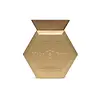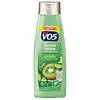What's inside
What's inside
 Key Ingredients
Key Ingredients

No key ingredients
 Benefits
Benefits

 Concerns
Concerns

 Ingredients Side-by-side
Ingredients Side-by-side

Water
Skin ConditioningSodium C14-16 Olefin Sulfonate
CleansingCocamidopropyl Hydroxysultaine
CleansingCoco-Glucoside
CleansingSalvia Hispanica Seed Extract
EmollientPPG-2 Hydroxyethyl Coco/Isostearamide
Panthenol
Skin ConditioningHydrolyzed Quinoa
Skin ConditioningAloe Barbadensis Leaf Juice
Skin ConditioningHelianthus Annuus Seed Extract
Skin ConditioningCarthamus Tinctorius Seed Oil
MaskingGlycerin
HumectantStarch Hydroxypropyltrimonium Chloride
Emulsion StabilisingGlyceryl Oleate
EmollientDicaprylyl Ether
EmollientDecyl Glucoside
CleansingPhenoxyethanol
PreservativeSodium Benzoate
MaskingCitric Acid
BufferingSodium Chloride
MaskingParfum
MaskingWater, Sodium C14-16 Olefin Sulfonate, Cocamidopropyl Hydroxysultaine, Coco-Glucoside, Salvia Hispanica Seed Extract, PPG-2 Hydroxyethyl Coco/Isostearamide, Panthenol, Hydrolyzed Quinoa, Aloe Barbadensis Leaf Juice, Helianthus Annuus Seed Extract, Carthamus Tinctorius Seed Oil, Glycerin, Starch Hydroxypropyltrimonium Chloride, Glyceryl Oleate, Dicaprylyl Ether, Decyl Glucoside, Phenoxyethanol, Sodium Benzoate, Citric Acid, Sodium Chloride, Parfum
Water
Skin ConditioningSodium Laureth Sulfate
CleansingSodium Chloride
MaskingCocamidopropyl Betaine
CleansingSodium Lauryl Sulfate
CleansingParfum
MaskingSodium Benzoate
MaskingPolyquaternium-7
Citric Acid
BufferingDisodium EDTA
Methylchloroisothiazolinone
PreservativeMethylisothiazolinone
PreservativePropylene Glycol
HumectantPolysorbate 20
EmulsifyingActinidia Chinensis Fruit Extract
EmollientCitrus Aurantifolia Peel Extract
CleansingCymbopogon Schoenanthus Leaf Extract
Skin ConditioningRosmarinus Officinalis Extract
AntimicrobialHelianthus Annuus Seed
Skin ConditioningMangifera Indica Seed Oil
EmollientPrunus Amygdalus Dulcis Oil
Skin ConditioningRosmarinus Officinalis Leaf Oil
MaskingAnthemis Nobilis Flower Oil
MaskingAscorbic Acid
AntioxidantPanthenol
Skin ConditioningTocopheryl Acetate
AntioxidantBiotin
AntiseborrhoeicNiacinamide
SmoothingCI 42090
Cosmetic ColorantCI 47005
Cosmetic ColorantWater, Sodium Laureth Sulfate, Sodium Chloride, Cocamidopropyl Betaine, Sodium Lauryl Sulfate, Parfum, Sodium Benzoate, Polyquaternium-7, Citric Acid, Disodium EDTA, Methylchloroisothiazolinone, Methylisothiazolinone, Propylene Glycol, Polysorbate 20, Actinidia Chinensis Fruit Extract, Citrus Aurantifolia Peel Extract, Cymbopogon Schoenanthus Leaf Extract, Rosmarinus Officinalis Extract, Helianthus Annuus Seed, Mangifera Indica Seed Oil, Prunus Amygdalus Dulcis Oil, Rosmarinus Officinalis Leaf Oil, Anthemis Nobilis Flower Oil, Ascorbic Acid, Panthenol, Tocopheryl Acetate, Biotin, Niacinamide, CI 42090, CI 47005
 Reviews
Reviews

Ingredients Explained
These ingredients are found in both products.
Ingredients higher up in an ingredient list are typically present in a larger amount.
Citric Acid is an alpha hydroxy acid (AHA) naturally found in citrus fruits like oranges, lemons, and limes.
Like other AHAs, citric acid can exfoliate skin by breaking down the bonds that hold dead skin cells together. This helps reveal smoother and brighter skin underneath.
However, this exfoliating effect only happens at high concentrations (20%) which can be hard to find in cosmetic products.
Due to this, citric acid is usually included in small amounts as a pH adjuster. This helps keep products slightly more acidic and compatible with skin's natural pH.
In skincare formulas, citric acid can:
While it can provide some skin benefits, research shows lactic acid and glycolic acid are generally more effective and less irritating exfoliants.
Most citric acid used in skincare today is made by fermenting sugars (usually from molasses). This synthetic version is identical to the natural citrus form but easier to stabilize and use in formulations.
Read more about some other popular AHA's here:
Learn more about Citric AcidPanthenol is a common ingredient that helps hydrate and soothe the skin. It is found naturally in our skin and hair.
There are two forms of panthenol: D and L.
D-panthenol is also known as dexpanthenol. Most cosmetics use dexpanthenol or a mixture of D and L-panthenol.
Panthenol is famous due to its ability to go deeper into the skin's layers. Using this ingredient has numerous pros (and no cons):
Like hyaluronic acid, panthenol is a humectant. Humectants are able to bind and hold large amounts of water to keep skin hydrated.
This ingredient works well for wound healing. It works by increasing tissue in the wound and helps close open wounds.
Once oxidized, panthenol converts to pantothenic acid. Panthothenic acid is found in all living cells.
This ingredient is also referred to as pro-vitamin B5.
Learn more about PanthenolParfum is a catch-all term for an ingredient or more that is used to give a scent to products.
Also called "fragrance", this ingredient can be a blend of hundreds of chemicals or plant oils. This means every product with "fragrance" or "parfum" in the ingredients list is a different mixture.
For instance, Habanolide is a proprietary trade name for a specific aroma chemical. When used as a fragrance ingredient in cosmetics, most aroma chemicals fall under the broad labeling category of “FRAGRANCE” or “PARFUM” according to EU and US regulations.
The term 'parfum' or 'fragrance' is not regulated in many countries. In many cases, it is up to the brand to define this term.
For instance, many brands choose to label themselves as "fragrance-free" because they are not using synthetic fragrances. However, their products may still contain ingredients such as essential oils that are considered a fragrance by INCI standards.
One example is Calendula flower extract. Calendula is an essential oil that still imparts a scent or 'fragrance'.
Depending on the blend, the ingredients in the mixture can cause allergies and sensitivities on the skin. Some ingredients that are known EU allergens include linalool and citronellol.
Parfum can also be used to mask or cover an unpleasant scent.
The bottom line is: not all fragrances/parfum/ingredients are created equally. If you are worried about fragrances, we recommend taking a closer look at an ingredient. And of course, we always recommend speaking with a professional.
Learn more about ParfumSodium Benzoate is a preservative. It's used in both cosmetic and food products to inhibit the growth of mold and bacteria. It is typically produced synthetically.
Both the US FDA and EU Health Committee have approved the use of sodium benzoate. In the US, levels of 0.1% (of the total product) are allowed.
Sodium benzoate works as a preservative by inhibiting the growth of bacteria inside of cells. It prevents the cell from fermenting a type of sugar using an enzyme called phosphofructokinase.
It is the salt of benzoic acid. Foods containing sodium benzoate include soda, salad dressings, condiments, fruit juices, wines, and snack foods.
Studies for using ascorbic acid and sodium benzoate in cosmetics are lacking, especially in skincare routines with multiple steps.
We always recommend speaking with a professional, such as a dermatologist, if you have any concerns.
Learn more about Sodium BenzoateChances are, you eat sodium chloride every day. Sodium Chloride is also known as table salt.
This ingredient has many purposes in skincare: thickener, emulsifier, and exfoliator.
You'll most likely find this ingredient in cleansers where it is used to create a gel-like texture. As an emulsifier, it also prevents ingredients from separating.
There is much debate on whether this ingredient is comedogenic. The short answer - comedogenic ratings don't tell the whole story. Learn more about comegodenic ratings here.
The concensus about this ingredient causing acne seems to be divided. Research is needed to understand if this ingredient does cause acne.
Scrubs may use salt as the primary exfoliating ingredient.
Learn more about Sodium ChlorideWater. It's the most common cosmetic ingredient of all. You'll usually see it at the top of ingredient lists, meaning that it makes up the largest part of the product.
So why is it so popular? Water most often acts as a solvent - this means that it helps dissolve other ingredients into the formulation.
You'll also recognize water as that liquid we all need to stay alive. If you see this, drink a glass of water. Stay hydrated!
Learn more about Water